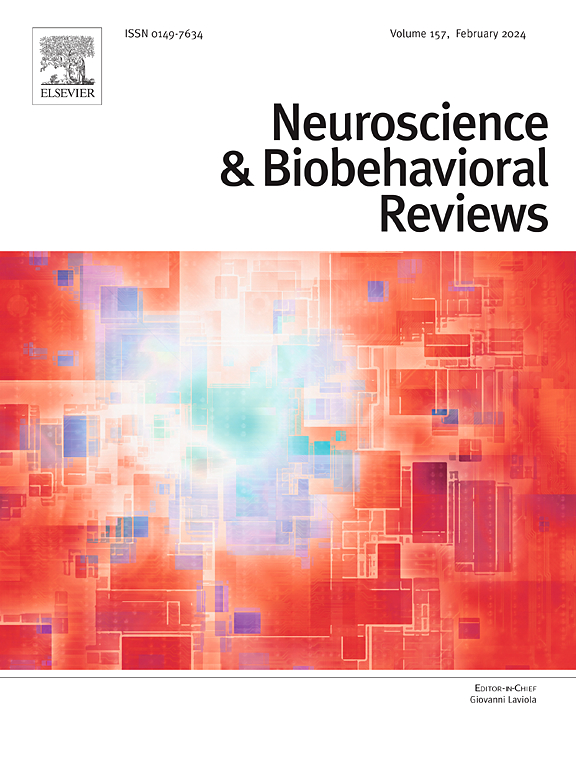精神病和心境障碍的阴性症状和静息状态功能连通性:一项系统的文献综述。
IF 7.9
1区 医学
Q1 BEHAVIORAL SCIENCES
引用次数: 0
摘要
阴性症状与精神病和情绪障碍的残疾和痛苦密切相关。由于对其神经学基础的了解有限,目前的治疗方法无效。连接障碍被认为是导致这些症状的原因,这使得研究静息状态功能连接有望开发有效的干预措施。本综述确定了40项研究,这些研究调查了基于节点的静息状态功能连接(特别是网络和图论分析)与精神障碍(即精神分裂症/分裂情感障碍)和具有精神病特征的情绪障碍(即双相情感障碍和重度抑郁症)的阴性症状之间的关系。有迹象表明,阴性症状与精神分裂症和分裂情感性障碍中几个静息状态网络的连通性有关,包括外侧额顶叶网络、扣带正中岛叶网络、内侧额顶叶网络、中央周围/躯体运动网络、枕叶网络和背额顶叶网络。有迹象表明,阴性症状与神经连接的功能分离和聚类减少有关。然而,考虑到现有文献的局限性和矛盾,有节制地解释这些发现是很重要的。最后,没有研究发现对具有精神病特征的重度抑郁症患者的阴性症状和功能连通性进行调查,对具有精神病特征的双相情感障碍患者进行的研究也很少。未来的研究应采用考虑阴性症状异质性的方法(如生态瞬时评估),提高静息状态功能连接方法(如自然刺激和个体特异性方法)的有效性和可靠性,并促进文献的凝聚力(如一致的网络分类法)。此外,未来的研究应该探索这些关系的跨诊断性质,为有效的临床干预提供信息。本文章由计算机程序翻译,如有差异,请以英文原文为准。
Negative symptoms and resting-state functional connectivity across psychotic and mood disorders: A systematic literature review
Negative symptoms are strongly linked to disability and distress across psychotic and mood disorders. Current treatments are ineffective due to a limited understanding of their neurological bases. Dysconnectivity is thought to contribute to these symptoms, which makes studying resting state functional connectivity promising for developing effective interventions. This review identified 40 studies that investigated the relationships between node-based resting-state functional connectivity (specifically network and graph theory analyses) and negative symptoms across psychotic disorders (i.e., schizophrenia/schizoaffective disorder) and mood disorders with psychotic features (i.e., bipolar and major depressive disorders). There were indications that negative symptoms are related to the connectivity of several resting-state networks in schizophrenia and schizoaffective disorder, including the lateral frontoparietal, midcingulo-insular, medial frontoparietal, pericentral/somatomotor, occipital, and dorsal frontoparietal networks. There were suggestions that negative symptoms are associated with decreased functional segregation and clustering of neural connections. Nevertheless, it is important to interpret these findings with restraint, given the limitations and contradictions in the existing literature. Lastly, no studies were found that investigated negative symptoms and functional connectivity in individuals with major depressive disorder with psychotic features, and very minimal research has been done on individuals with bipolar disorder with psychotic features. Future studies should employ methods that account for negative symptoms’ heterogeneity (e.g., ecological momentary assessment), increase validity and reliability of resting state functional connectivity methods (e.g., naturalistic stimuli and individual-specific methods), and promote cohesion in the literature (e.g., consistent network taxonomy). Moreover, future research should explore the transdiagnostic nature of these relationships to inform effective clinical interventions.
求助全文
通过发布文献求助,成功后即可免费获取论文全文。
去求助
来源期刊
CiteScore
14.20
自引率
3.70%
发文量
466
审稿时长
6 months
期刊介绍:
The official journal of the International Behavioral Neuroscience Society publishes original and significant review articles that explore the intersection between neuroscience and the study of psychological processes and behavior. The journal also welcomes articles that primarily focus on psychological processes and behavior, as long as they have relevance to one or more areas of neuroscience.

 求助内容:
求助内容: 应助结果提醒方式:
应助结果提醒方式:


